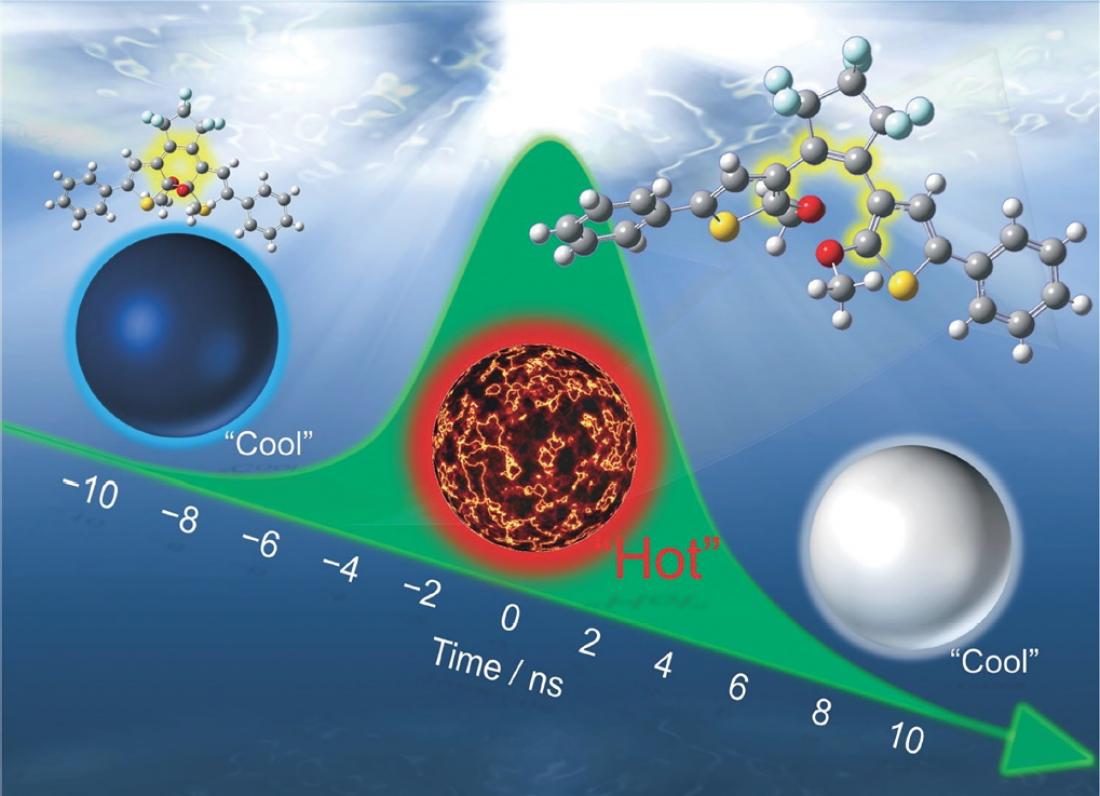Schematic illustration of the heating of the nanoparticle and the amplification of the photochemical reaction during nanosecond laser pulse excitation.
Intense nanosecond 532-nm pulse laser excitation to aqueous nanoparticles colloids of a photochromic diarylethene induced drastic amplification of the ring-opening reaction yield. This mechanism was explained as a ‘photosynergetic response’ coupled with the nanoscale laser heating and the photochemical reaction in the nanoparticle.
A research team in Ehime University found a drastically amplified ring-opening reaction yield in aqueous nanoparticle colloids of a photochromic diarylethene when induced by an intense nanosecond laser pulse, and clarified its amplification mechanism. The findings were published on July 4, 2020, in Chemical Communications and appeared on the back cover of the journal.
Organic molecules in a solid have a different environment from a molecule in solution because of the restricted molecular motions/vibrations and the electronically mutual interactions between neighboring molecules. The organic solids are expected to show different photochemical reactions and photophysical properties from the solution. Especially, light irradiation with high photon density such as an ultrashort pulse laser to the solid allows interactions between multi-chromophore and multi-photons, leading to novel photochemical reactions which cannot be realized by conventional light irradiation.
In this study, we focused on a diarylethene derivative as an organic solid sample. Diarylethene derivatives, first synthesized by Prof. Irie at Kyushu University show a photoinduced reversible transformation between a colorless open form and a colored closed form. The chemical bond rearrangement during the photo-transformation rapidly induces not only the change of color but also of various physical and chemical properties such as fluorescence spectra, refractive indices, oxidation/reduction potentials, and chiral properties. Recently, many researchers in the world reported that diarylethene crystals showed photomechanical functions by utilizing their shape changes such as expansion/shrinkage, and bending and curling by light. Therefore, diarylethene derivatives have been attracting much attention as a next-generation photoenergy conversion material.
In this study, we prepared aqueous nanoparticle colloids of a closed-form diarylethene derivative by the reprecipitation method, and examined the ring-opening reaction yield from closed to open forms after irradiation of a single-shot nanosecond laser pulse (Excitation wavelength; 532 nm, Pulse duration; 6 ns). As a result, the reaction yield of the nanoparticles showed a third-order increase with the laser fluence, while that of the solution increased monotonously. That is, we found for the first time that the non-linear increase of the reaction yield by the nanosecond laser pulse was observed only in the nanoparticle. The mechanism of the amplified ring-opening reaction could be explained by a ‘photosynergetic effect’ coupled with nanoscale photothermal conversion and the photochemical reaction in a nanoparticle, on the basis of the results by the steady-state and time-resolved spectroscopies. As distinct from the simple temperature effect, the nanoscale laser heating effect, i.e. photothermal conversion of the excited molecule and thermal conduction on the nanometer length scale, plays an important role. Briefly, one closed-form molecule excited by one photon in a ns pulse heated up surrounding molecules (generating a hot cluster consisting of plural molecules with high temperatures). When another molecule in the hot cluster absorbs another photon of the same pulse, the enhanced ring-opening reaction would take place under such a transient high-temperature condition. This process depends on the mutual interaction between a multi-chromophore and a multi-photon, which can be induced by the combination of an organic solid with high molecular density and a ns laser pulse with a high photon density. These results will deepen understanding of the ‘photosynergetic response’ characteristic of novel laser-induced reactions of solid photofunctional materials.



